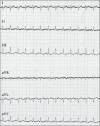Concurrent administration of heparin and activated protein C in a patient with pulmonary embolism and severe sepsis with positive outcome
- PMID: 20040816
- PMCID: PMC2823100
- DOI: 10.4103/0972-5229.58544
Concurrent administration of heparin and activated protein C in a patient with pulmonary embolism and severe sepsis with positive outcome
Abstract
Results of the PROWESS trial suggested that heparin may reduce the efficacy of recombinant human activated protein C (rhAPC) and the XPRESS study also showed increased bleeding complications in patients receiving heparin with rhAPC. Although it has been shown that heparin prophylaxis may be used along with rhAPC, no study has shown the interaction between continuous heparin infusion and rhAPC. Here, we report a case of severe sepsis with pulmonary embolism who was concurrently administered heparin and rhAPC infusions, with positive results and no bleeding complications.
Conflict of interest statement
Figures
Similar articles
-
A case report of a new pulmonary embolism occurring in a patient receiving continuous infusion of recombinant activated protein C.World J Emerg Surg. 2006 Aug 9;1:23. doi: 10.1186/1749-7922-1-23. World J Emerg Surg. 2006. PMID: 16899129 Free PMC article.
-
Cost-effectiveness of recombinant human activated protein C and the influence of severity of illness in the treatment of patients with severe sepsis.J Crit Care. 2003 Sep;18(3):181-91; discussion 191-4. doi: 10.1016/j.jcrc.2003.08.009. J Crit Care. 2003. PMID: 14595571
-
Recombinant human activated protein C improves pulmonary function in ovine acute lung injury resulting from smoke inhalation and sepsis.Crit Care Med. 2006 Sep;34(9):2432-8. doi: 10.1097/01.CCM.0000230384.61350.FA. Crit Care Med. 2006. PMID: 16810106
-
Recombinant human activated protein C in sepsis: assessing its clinical use.Am J Med Sci. 2004 Oct;328(4):215-9. doi: 10.1097/00000441-200410000-00004. Am J Med Sci. 2004. PMID: 15486536 Review.
-
[Novel treatment for severe sepsis: recombinant human protein C (RHAPC)].Ginekol Pol. 2005 Nov;76(11):913-20. Ginekol Pol. 2005. PMID: 16566369 Review. Polish.
References
-
- Angus DC, Linde-Zwirble WT, Lidicker J, Clermont G, Carcillo J, Pinsky MR. Epidemiology of severe sepsis in the United States: Analysis of incidence, outcome, and associated costs of care. Crit Care Med. 2001;29:1303–10. - PubMed
-
- Bernard GR, Vincent JL, Laterre PF, LaRosa SP, Dhainaut JF, Lopez-Rodriguez A, et al. Efficacy and safety of recombinant human activated protein C for severe sepsis. N Engl J Med. 2001;344:699–709. - PubMed
-
- Eisele B, Lamy M, Thijs LG, Keinecke HO, Schuster HP, Matthias FR, et al. Antithrombin III in patients with severe sepsis. A randomized, placebo-controlled, double-blind multicenter trial plus a meta-analysis on all randomized, placebo-controlled, double-blind trials with antithrombin III in severe sepsis. Intensive Care Med. 1998;24:663–72. - PubMed
-
- Zarychanski R, Doucette S, Fergusson D, Roberts D, Houston DS, Sharma S, et al. Early intravenous unfractionated heparin and mortality in septic shock. Crit Care Med. 2008;36:2973–9. - PubMed
-
- Abraham E, Reinhart K, Opal S, Demeyer I, Doig C, Rodriguez AL, et al. Efficacy and safety of tifacogin (recombinant tissue factor pathway inhibitor) in severe sepsis: A randomized controlled trial. JAMA. 2003;290:238–47. - PubMed
Publication types
LinkOut - more resources
Full Text Sources


